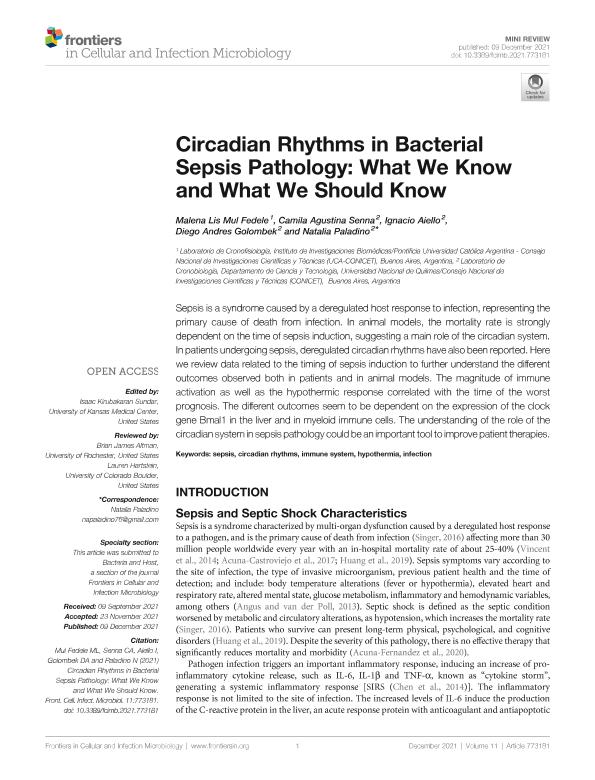Artículo
Circadian rhythms in bacterial sepsis pathology: What we know and what we should know
Mul Fedele, Malena Lis ; Senna, Camila Agustina
; Senna, Camila Agustina ; Aiello, Ignacio
; Aiello, Ignacio ; Golombek, Diego Andrés
; Golombek, Diego Andrés ; Paladino, Natalia
; Paladino, Natalia
 ; Senna, Camila Agustina
; Senna, Camila Agustina ; Aiello, Ignacio
; Aiello, Ignacio ; Golombek, Diego Andrés
; Golombek, Diego Andrés ; Paladino, Natalia
; Paladino, Natalia
Fecha de publicación:
09/12/2021
Editorial:
Bacteria and Host
Revista:
Frontiers in Cellular and Infection Microbiology
e-ISSN:
2235-2988
Idioma:
Inglés
Tipo de recurso:
Artículo publicado
Clasificación temática:
Resumen
Sepsis is a syndrome caused by a deregulated host response to infection, representing the primary cause of death from infection. In animal models, the mortality rate is strongly dependent on the time of sepsis induction, suggesting a main role of the circadian system. In patients undergoing sepsis, deregulated circadian rhythms have also been reported. Here we review data related to the timing of sepsis induction to further understand the different outcomes observed both in patients and in animal models. The magnitude of immune activation as well as the hypothermic response correlated with the time of the worst prognosis. The different outcomes seem to be dependent on the expression of the clock gene Bmal1 in the liver and in myeloid immune cells. The understanding of the role of the circadian system in sepsis pathology could be an important tool to improve patient therapies.
Palabras clave:
SEPSIS
,
CIRCADIAN RHYTHMS
,
IMMUNE SYSTEM
,
HYPOTHERMIA
,
INFECTION
Archivos asociados
Licencia
Identificadores
Colecciones
Articulos(SEDE CENTRAL)
Articulos de SEDE CENTRAL
Articulos de SEDE CENTRAL
Citación
Mul Fedele, Malena Lis; Senna, Camila Agustina; Aiello, Ignacio; Golombek, Diego Andrés; Paladino, Natalia; Circadian rhythms in bacterial sepsis pathology: What we know and what we should know; Bacteria and Host; Frontiers in Cellular and Infection Microbiology; 11; 773181; 9-12-2021; 1-8
Compartir
Altmétricas



